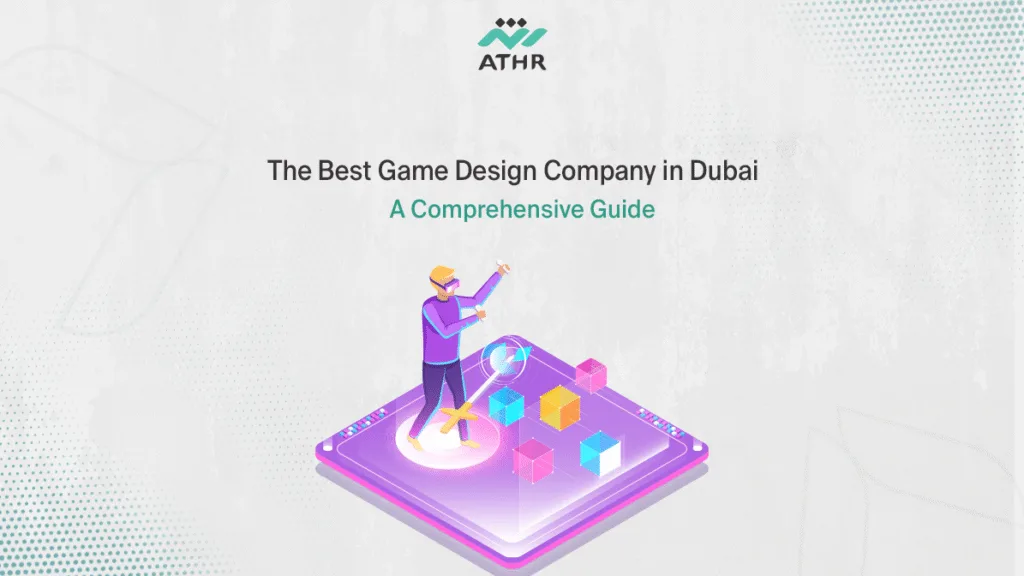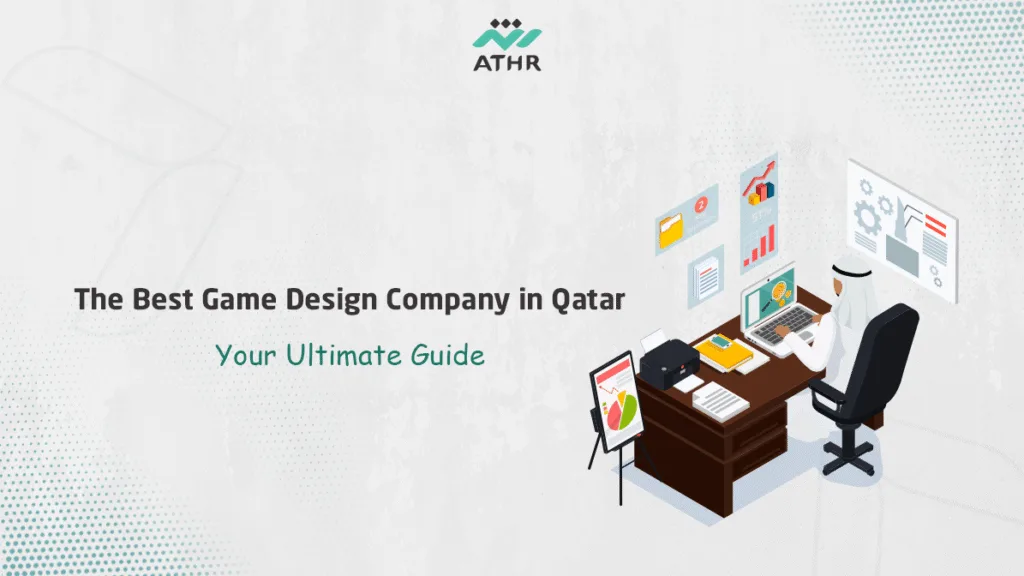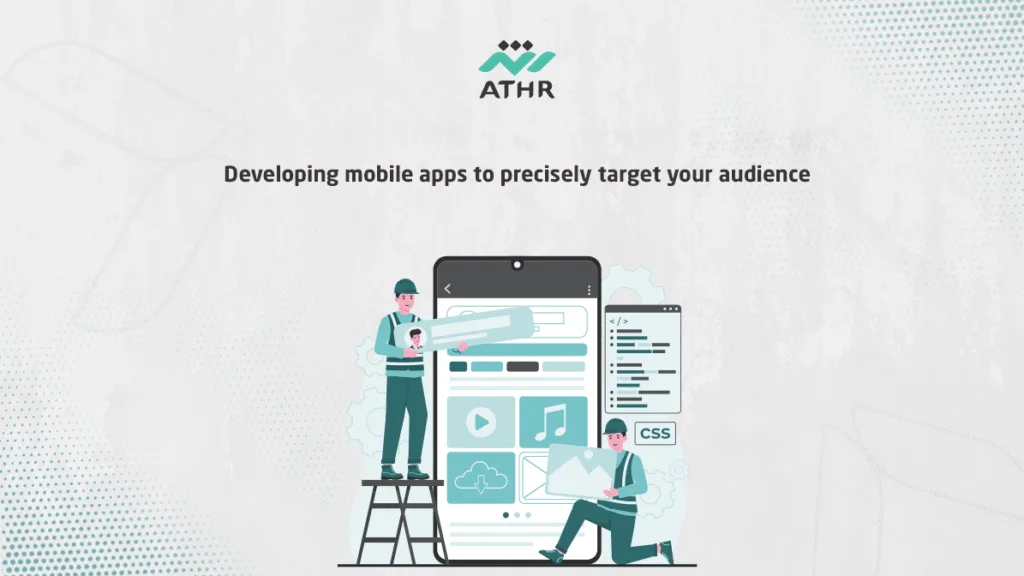Every app idea starts with a small spark… but what distinguishes a successful application is how that idea is translated into a real experience.
In a world where technology is accelerating, mobile Application development and design now rely on both creativity and intelligence.
From Artificial Intelligence (AI) to Flutter and React Native, we’ll take you on a journey to discover the latest programming technologies that transform your idea into a professional application with the experts at Athr Company.
💼 Every successful app began with an idea – Share yours, and let us execute it professionally for you.
جدول المحتوي
- How Design and Programming Come Together to Create a Successful Application?
- The Latest Mobile Application Programming Technologies in 2025
- Mobile Application Development and Design Steps from Start to Finish
- Comparison Between Native and Hybrid App Development – Which is Best for Your Project?
- Cybersecurity Techniques in Modern Mobile App Design
- How can a mobile application help my project grow?
- How long does the process of developing a professional mobile application take?
- Is it possible to develop an application that works on both Android and iOS?
- How do I ensure my application is secure and protects user data?
- Can the application be linked to an e-commerce store or an internal system?
- What are the mistakes that should be avoided during mobile application development?
- Can Artificial Intelligence be used in mobile applications?
How Design and Programming Come Together to Create a Successful Application?
The secret behind the success of any mobile application lies not just in the code or the external appearance, but in the harmony between design and programming.
A good application is the result of effective collaboration between designers and developers, where visual creativity is translated into a practical and seamless user experience.
The designer draws the user’s first impression map through attractive and easy-to-use interfaces, while the developer works to develop the application, transforming this map into a real experience supported by performance, technical intelligence, and continuous innovation.
This highlights the importance of combining the latest mobile application development technologies with modern mobile UI design to build a complete digital product that attracts users and achieves business goals.
The Role of User Interface (UI) Design in Attracting the User from the First Moment
User Interface Design (UI Design) is the step that creates the user’s first impression. From the moment they open the app, the visual communication journey begins, determining whether they will continue or close the app immediately.
Here are the most important elements that make an application interface effective and attractive:
- Visual Consistency and Unified Identity: Using consistent colors and fonts that reflect the brand’s personality.
- Easy Navigation: Designing menus and buttons in a clear and intuitive way that makes the user feel comfortable.
- Focus on the Visual Element: Images, icons, and light animations help guide the user within the application.
- Responsive Design Across Devices: Whether on Android or iOS, the user experience must remain consistent and comfortable.
🎯At Athr Company, we focus on designing attractive and easy-to-use interfaces that increase user retention by up to 45% compared to traditional designs.
The Impact of Collaboration Between Designers and Developers on Launch Speed and Performance Improvement
Collaboration between design and development teams is considered one of the most important secrets to the success of modern tech projects. In the past, the designer would hand over the prototype to the developer, and execution would begin separately, leading to gaps in understanding and launch delays.
However, today, with the adoption of integrated development tools such as Figma, Flutter, and React Native, collaboration has become smoother and more effective.
How Does This Collaboration Translate into Tangible Results?
- Speed in the Development Process: Thanks to direct integration between design tools and code, the time required to convert prototypes into actual interfaces is reduced by up to 30%.
- Reduction of Technical Errors: The designer and developer work in a unified environment, which reduces misunderstandings and improves the quality of the final experience.
- Performance and User Experience Improvement: By integrating design directly with code, performance can be tested at every stage to ensure speed and stability.
- Faster App Launch: Early collaboration between the two teams reduces review and modification stages, allowing the application to reach the store in record time.
If you are thinking of developing an app and want to succeed in the Gulf, this article is written for you!👈
The Latest Mobile Application Programming Technologies in 2025
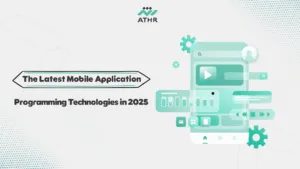
The year 2025 is witnessing an unprecedented leap in mobile application development and design, where programming is no longer just about writing code, but has become an art based on Artificial Intelligence and interactive experiences. Modern technologies have changed how companies think about building applications, focusing on improving the User Experience (UX), increasing performance speed, and enhancing security and flexibility.
Artificial Intelligence (AI) and its Role in Improving the User Experience
Artificial intelligence is no longer a luxury; it has become the brain that understands the user within every successful application. Thanks to AI algorithms and Machine Learning, mobile applications can analyze user behavior and predict their needs to offer a personalized and unique experience.
How Does AI Change the User Experience?
- Smart Recommendations: Like what you see on Netflix or Spotify, where content is suggested based on your preferences.
- Smart Chatbots: That provide immediate support to the user without human intervention.
- Sentiment Analysis: To interpret user interactions and understand their satisfaction with the service.
- Smart Security: By using face and voice recognition technologies for secure and easy login.
Integration with Augmented Reality (AR) and Virtual Reality (VR) Technologies
The blending of the real and virtual worlds has become an essential part of the user experience. Augmented Reality (AR) and Virtual Reality (VR) technologies help transform applications into interactive environments that give the user a real sense of participation.
Practical Applications of These Technologies:
- E-commerce: Seeing the product in the user’s environment before purchase (e.g., trying furniture at home).
- Education and Training: Simulating scientific lessons or real-life situations interactively for a better learning experience.
- Medical Sector: Using AR apps to train doctors or help patients understand surgical procedures.
- Gaming: Building realistic 3D worlds that increase user immersion in the experience.
At Athr Company, we use AR and VR technologies in mobile app design for educational and interactive games to provide immersive and distinctive experiences that enhance user loyalty and increase their engagement time within the app.
Using Cross-Platform Technologies like Flutter and React Native
One of the most important transformations in the world of modern mobile application development is the reliance on Cross-Platform Development technologies, which allow building a single application that works efficiently on Android and iOS simultaneously.
The Most Famous Technologies Used in This Field:
| Technology | Origin | Language Used | Key Feature | Development Time |
| Flutter | Dart | High execution speed, Smooth UI, Hot Reload | Reduces time by up to 40% | |
| React Native | Meta | JavaScript | Easy integration with Web and backend services | Suitable for strong performance with custom interfaces |
Why Do Large Companies Rely on Cross-Platform?
- Reduced Costs and Time: Instead of building two separate applications.
- Unified User Experience: Same performance and look across all devices.
- Easier Maintenance and Faster Updates.
💡At Athr Company, we use a mix of Flutter and React Native to develop Android and iOS applications for businesses, ensuring performance close to Native Apps in terms of speed and interaction, which helps clients launch their projects in record time and with world-class quality.
Get a free consultation for application development using the latest programming technologies.
Mobile Application Development and Design Steps from Start to Finish
When you begin the journey of mobile app development and design, it’s not enough to just have a great idea; you must go through several measured stages that ensure project success and achieve your business goals. Successful applications are not built by chance, but through a comprehensive development plan that includes analysis, design, programming, and testing before the official launch.
Analyzing the App Idea and Defining its Business Goals
Before writing the first line of code, the process starts with analysis and planning. This stage is the foundation for any successful project because it determines the app’s path from the beginning to reaching the end-user.
Key Steps in Analyzing the App Idea:
- Market and Competitor Study: Identifying similar apps and analyzing their weaknesses to offer a better experience.
- Defining the Target Audience: Knowing the age group, interests, and digital behavior to ensure the app meets their needs.
- Defining Business Goals: Is the purpose of the app direct selling? Attracting customers? Or building brand loyalty?
- Choosing the Right Platform: Deciding whether the app will run on Android or iOS, or if it will be developed with Cross-Platform technologies like Flutter or React Native.
Programming and Experimental Design Stages Before Launch
After completing the idea analysis and defining the goals, the application design and programming stage begins—this is the stage where the concept turns into a real product. This phase is the most critical because it determines the quality of the user experience and the app’s performance after launch.
Key Stages in Modern Mobile App Programming and Design:
1. Wireframes: Designing the usage map to clarify the navigation flow within the app.
2. Interactive Interface Design (UI Design): Using tools like Figma or Adobe XD to create an attractive visual experience.
3. Application Programming (Development):
- Using languages like Kotlin and Swift for Native applications.
- Or Flutter and React Native to develop an app that runs on multiple systems.
4. Internal Testing: Checking the app for bugs and improving performance speed and interface responsiveness.
5. Beta Testing: Launching a limited trial version to gather feedback from users and improve the experience before official publishing.
💬Athr Company experts rely on an Agile Development Cycle, which allows for working in parallel stages and continuously updating the application to ensure speed of completion without sacrificing quality.
What Must You Ensure is Available Before Uploading Your App to the Store?
Before hitting the “Publish” button, there are a set of things that must be confirmed to ensure the app is technically and commercially ready for launch. Good preparation for the launch can increase the app’s success rate by 70% compared to apps launched randomly.
✅ Pre-Publishing Checklist:
1. Ensuring the app is free of technical errors (Bugs).
2. Optimizing loading speed and interface performance.
3. Adding the correct Permissions (e.g., camera, location, or notifications).
4. App Store Optimization (ASO):
- Writing an attractive description that includes keywords like “modern mobile application development.”
- Adding images and videos that explain the user experience.
5. Activating Analytics System: To monitor app performance after launch and analyze user behavior.
6. Preparing a Strong Marketing Plan: Including sponsored ads, promotional content, landing pages, and internal links to your main website.
📈 At Athr Company, our work does not end with programming the app; we accompany the client through the launch and marketing phase, from store preparation to managing advertising campaigns, to ensure the highest rates of downloads and interaction are achieved.
Technical evolution waits for no one… 📘 Learn about the latest mobile application development technologies in 2025.
Comparison Between Native and Hybrid App Development – Which is Best for Your Project?
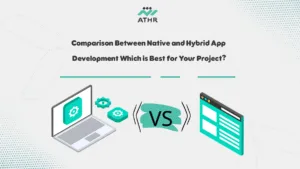
When starting an application development and design project, business owners and companies face a pivotal question: Is it better to develop a Native or Hybrid application?
The choice between them is not simple; it depends on the nature of the project, the budget, and the target audience.
Advantages and Disadvantages of Native Apps
Native applications are built specifically for a particular operating system, such as Android using Kotlin or Java, or iOS using Swift or Objective-C. They are the best choice when the goal is to provide strong performance and an ideal user experience.
Native Apps Advantages:
- Superior Speed Performance: Because they are programmed directly on the core system without intermediate layers.
- Full Utilization of Device Capabilities: Such as the camera, GPS, sensors, and smart notifications.
- Enhanced User Experience (UX): Smoother and more responsive interfaces due to their compatibility with the system environment.
- Higher Security: As they rely on official development environments from Google and Apple.
Native Apps Disadvantages:
- Higher Development Cost: Because you need two separate teams for Android and iOS development.
- Longer Time to Launch: Developing each version requires additional time.
- Double Maintenance: Any update must be applied to both versions independently.
Why Do Companies Turn to Hybrid Apps?
Hybrid applications are developed using web technologies such as HTML, CSS, and JavaScript, and run on multiple operating systems through a single framework like Flutter or React Native. This is the optimal choice for startups or projects that need a quick launch at a lower cost.
Hybrid Apps Advantages:
- One App for All Systems: Developing a single codebase is enough to run on both Android and iOS.
- Lower Cost: 40–60% less compared to native apps.
- Easier Updates and Maintenance: The code is modified once to apply changes across all systems.
- Speed of Launch: Ideal for companies that want to quickly test their idea in the market (MVP).
Hybrid Apps Disadvantages:
- Slightly Lower Performance than Native: Due to the intermediate layer between the code and the operating system.
- Limitations in Using Some Device Features: Not all system capabilities can always be accessed with the same flexibility.
- Reliance on External Libraries: Which requires periodic follow-up to ensure compatibility with new updates.
The Best Framework for Developing a Flexible and High-Performance Application
Both Flutter and React Native dominate the hybrid application development market due to their strength and flexibility. With continuous updates from Google and Meta, it is now possible to develop an app that enjoys near-native performance.
Quick Comparison Between Flutter and React Native:
| Criterion | Flutter (Google) | React Native (Meta) |
| Language Used | Dart | JavaScript |
| Performance | Very fast and smooth | Good with some differences in graphics |
| Design Flexibility | Relies entirely on custom Widgets | More compatible with native system interfaces |
| Updates & Support | Supported by Google with continuous updates | Large developer community and many tools |
| Project Suitability | Ideal for medium and large business applications | Excellent for applications requiring high development speed |
💡 At Athr Company, we choose the technology based on the project type:
- Flutter for projects requiring integrated performance and design experience.
- React Native for fast projects that need flexibility and web compatibility.
🔒Get a secure and fast application based on the latest global programming standards.
Cybersecurity Techniques in Modern Mobile App Design
In an era where cyberattacks are increasing daily, cybersecurity has become an integral part of the mobile application development and design process.
Even the strongest applications in terms of performance and appearance can completely lose their value if they are not well protected against hacking or data leakage.
Since today’s users are more aware of their privacy, app security is no longer an option, but a key trust factor that determines the success or failure of any application in the market. Therefore, leading mobile app design companies—including Athr Company—rely on the latest cybersecurity techniques to provide secure and reliable applications that protect user data and safeguard brand reputation.
How to Protect User Data and Earn Their Trust?
The user will not grant their trust to an application they do not feel safe with. Every click, login, or payment operation represents a great responsibility for the app developer. Therefore, the first step to earning user loyalty starts with designing a secure app from the beginning, not after discovering vulnerabilities.
Key User Data Protection Practices:
- Data Encryption: The cornerstone of protecting sensitive information like passwords and payment data. Protocols like AES-256 and TLS 1.3 are used to secure the connection between the user and servers.
- Two-Factor Authentication (2FA): Adds an extra layer of security by sending a verification code to a phone number or email.
- Permissions Management: The app should not request unnecessary permissions (like the camera or location), as this may raise user suspicion.
- Regular Security Updates: Keeping the app constantly updated closes security gaps before they are exploited by attackers.
Tools and Applications to Help Secure Your App Against Attacks
Many advanced tools are available today that help developers discover vulnerabilities early and secure code professionally. Here are the most prominent tools relied upon by experts in modern mobile application development and design:
Key Cybersecurity Tools in Mobile App Development:
- OWASP Mobile Security Project: A comprehensive guide to best practices for mobile app security, identifying the most common types of vulnerabilities and prevention methods.
- Firebase App Check (from Google): An effective tool for verifying user identity and preventing unauthorized access to application backend interfaces (APIs).
- Burp Suite and ZAP Proxy: Used for Penetration Testing before launch to ensure there are no security vulnerabilities.
- Keychain (for iOS) and Keystore (for Android): For storing sensitive passwords and tokens on the device in an encrypted manner that is difficult to breach.
- Seurity Headers and SSL Pinning: Enhance the protection of encrypted communications and prevent attacks targeting data interception (Man-in-the-Middle Attacks).
A successful app design starts with a clear strategy — 📖 Discover how to do that in this article.
In a rapidly evolving world, a successful mobile app design is more than just code or a beautiful interface—it’s an integrated experience that translates the project vision into a tangible reality in the hands of users.
Your next application can be the first step towards a major digital success if you start it with a smart strategy and professional execution that balances design, performance, and user experience.
At Athr Company, we help you transform your idea into a complete application that stands out in the Android and iOS market and gives you a real competitive advantage.
Collaborate with Athr Company and be part of the digital future with confidence.


